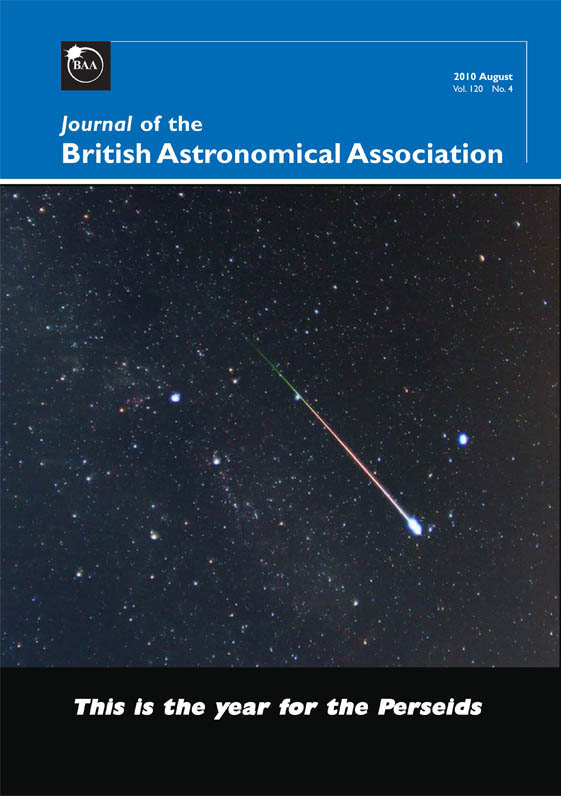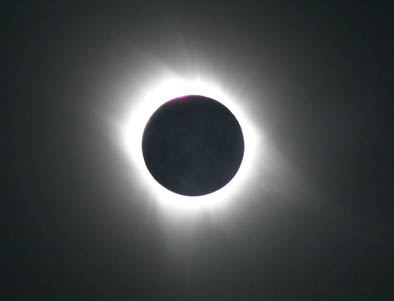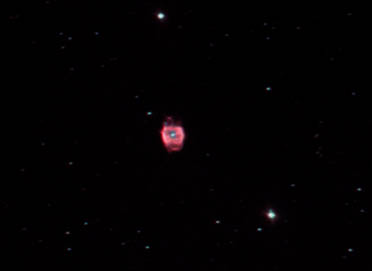 The Journal
of the British Astronomical Association
The Journal
of the British Astronomical Association
Volume 120, No.4: 2010 August
 Summary
contents page
Summary
contents page
Detailed contents: Notes and News / Articles / Observers' Forum /
Reviews / Letters / Meetings / BAA Update


Cover image
A bright Perseid streaks down the Milky Way between Deneb and Vega
early on 2009 August 12. (Peter
Lawrence)
Project Perseid 2010 (John Mason)
/ From the President (David Boyd
) / New Honorary Members / Beyond the International Year of
Astronomy (Steve Owens) /
Project Neil Bone: a great success! (Richard Miles) / Solar
Section (Lyn Smith) / More evidence of increasing solar activity
(Paul Hyde) / Supernova
news (Stewart L. Moore)

The solar eclipse of 2010 July 11 always promised to be a logistical
nightmare to observe. The Moon’s shadow first touched the Earth in the
southern Pacific, encountering land at
Mangaia in the Cook Islands only after 1450km of open ocean. The narrow
track of totality then swung northeast, passing tantalisingly close to
the islands of Tahiti and Moorea, which experienced a 98% partial
eclipse. Beyond Tahiti the track crossed the Tuamotu archipelago of
French Polynesia - thousands of tiny coral atolls, of which very few
are inhabited, and even fewer have airstrips that make them accessible
to visitors. The track then sped across 3300km of empty Pacific to
Easter
Island, known as one of the world’s most isolated inhabited islands,
and after another 3700km it finally made continental landfall at sunset
in winter on the rugged and inaccessible coast of Chile. Crossing the
Andes, the shadow left the Earth after entering Argentina at the
tourist resort of El Calafate, where the eclipsed Sun was a mere 1°
above the mountainous horizon.
According to NASA, nowhere on the track had weather
prospects better
than 50% of cloud, but the Tuamotus offered the best chances, with
Easter Island notoriously experiencing its rainy season in July. Two
major UK-based expeditions both based their operations in Tahiti, with
its substantial tourist infrastructure, and
chartered aircraft to
travel to three inhabited atolls within the eclipse path.... more
Image:
the corona at mid-totality, by Martin Mobberley
Saturn during the 2006/2007 apparition ... Mike
Foulkes
There were two major events during this
apparition. Firstly, a light spot was observed between the components
of the South Equatorial Belt and was followed from 2006 November until
2007 April. A reliable drift was derived; this spot showed a
noticeable prograde (negative) drift with respect to Saturn’s System 3
longitude system. The derived period for this spot may be a potential
first for the Section, but this will be confirmed when the analysis of
earlier outstanding apparitions has been completed.
Secondly, the initial phase of a rare transit of the
satellite Iapetus was successfully observed on the night of 2007
January 6/7.
CSS090530:144011+494734: a new SU UMa-type dwarf
nova in Boötes ... David Boyd, Nick Dunckel, Jerry Foote
& Ian Miller
We report photometry
and analysis of a previously unknown SU UMa-type dwarf nova in
Boötes detected in outburst by the Catalina Real-time Transient
Survey on 2009 May 30, with the discovery identifier
CSS090530:144011+494734. This apparently stellar object had previously
been catalogued by the Sloan Digital Sky Survey as SDSS
J144011.01+494733.4. We measured its mean superhump period over the
first 3 days following detection as 0.06500(4)d, at which point this
changed to 0.06438(3)d. We detected a possible orbital period of
0.06322(8)d implying a mean superhump period excess of 0.020(2). After
detection, the dwarf nova maintained steady brightness for 5 days
before starting to fade. The outburst amplitude was 5.5 magnitudes
above its quiescent level.
The comets of 2000 ... Jonathan Shanklin
This report is the eleventh in the
annual series which gives for each comet: the discovery details,
orbital data and general information, magnitude parameters and BAA
Comet Section observations. Further details of the analysis techniques
used in this report are given in an earlier paper. Ephemerides for the
comets predicted to return during the year can be found in the BAA or
ICQ Handbooks.
(Short paper): The first
Pic du Midi photographs of Mars, 1909 ... Audouin Dollfus
This short paper comprises an English
translation of the article ‘1909; Premieres photographies de Mars au
Pic du Midi’, by Audouin Dollfus, published in l’Astronomie, 2009 November, pp.
27–30, and printed here with the assistance of the Director of the BAA
Mars Section, Dr Richard McKim.
Click here to obtain a PDF file of
any of these articles

-
A note on the
remarkable prominence of
‘lumen cinereum’, 2009 March 29 ... Nigel Longshaw
-
NGC 40 - an intriguing planetary nebula in Cepheus ... Stewart L. Moore
- Left:
Image of NGC 40 by Bob Garner
- The partial solar eclipse of
2011 January 4 ... Peter
Macdonald
- A Venus green flash ... Colin Henshaw, Rob Peeling & Mike
Maunder
- Astronomers have observed
noctilucent clouds for 125 years ... Wilfried Schröder
- Observing Saturn this apparition
... David Arditti
- An appeal for Doherty art ... Dale Holt
- The ‘nominative takeover’ ... Michael A. Covington
BAA
Update
- Meeting of the Deep Sky Section,
20110 March 6 ... Lee
Macdonald
- Obituary: Geoffrey Amery,
1928–2010 ... Bill
Leatherbarrow
Meetings
 Out-of-London Meeting, 2009 September
4–6, Leeds ... Ray Emery
Out-of-London Meeting, 2009 September
4–6, Leeds ... Ray Emery- Annual General Meeting &
Ordinary Meeting, 2009 October 28 ... Hazel McGee
Why not join us at a BAA meeting near you? Meetings are open to
all and you will be made very welcome. Click here for the
latest
Meetings Diary

 Sky
notes for 2010 August & September by Callum Potter
Sky
notes for 2010 August & September by Callum Potter
Jupiter is very favourable these
months, as it approaches opposition on Sept 21. At the start of August
the planet’s disk will be around 46 arcseconds, which will rise to
nearly 50" at opposition. On August 27, the Moon will be just a few
degrees away, and may make an interesting photo opportunity.
The disappearance of the South
Equatorial Belt was quite a surprise when Jupiter re-appeared this
year, but it will surely be just a matter of time before it returns,
and there may be interesting storms to be seen, so regular observations
are recommended. ...more
(Image of Jupiter and Ganymede on 2010 June 3 by Peter Garbett)
Back to top of page
 Go
to the BAA Journal
home page
Go
to the BAA Journal
home page
 The Journal
of the British Astronomical Association
The Journal
of the British Astronomical Association The Journal
of the British Astronomical Association
The Journal
of the British Astronomical Association

 Notes and News
Notes and News The total solar eclipse of
2010 July 11 by
Hazel McGee, Nick James & John Mason
The total solar eclipse of
2010 July 11 by
Hazel McGee, Nick James & John Mason 
 Observers'
Forum
Observers'
Forum
 Letters
Letters Out-of-London Meeting, 2009 September
4–6, Leeds ... Ray Emery
Out-of-London Meeting, 2009 September
4–6, Leeds ... Ray Emery
 Sky
notes for 2010 August & September by Callum Potter
Sky
notes for 2010 August & September by Callum Potter